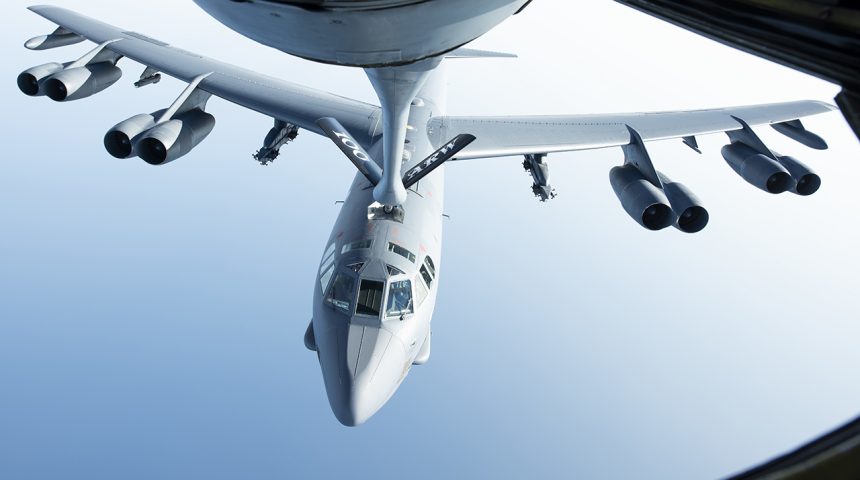U.S. Air Force B-52H Stratofortress strategic bombers from Minot Air Force Base have conducted a surprise, round-trip to the Persian Gulf area “to deter aggression and reassure U.S. partners and allies”.
On Nov. 21, 2020, two U.S. Air force B-52 bombers belonging to the 5th Bomb Wing, from Minot AFB, North Dakota, carried out a round-trip mission to the Middle East region.
According to a press release by U.S. Central Command, the mission to the CENTCOM AOR (Area of Responsibility) was launched on a short-notice “to deter aggression and reassure U.S. partners and allies.”
The two BUFFs, using radio callsign WARBIRD 1 and 2, could be tracked online as they crossed the Pond, entered the Med Sea through Gibraltar then flew eastbound until they entered the Israeli airspace. Mode-S/ADS-B tracking was lost as they overflew Jordan proceeding towards the Gulf area.
USAF B-52Hs #WARBRD1 & 2 departed Minot AFB, North Dakota on a 24+ hour round-trip Global Power Mission to the Middle East region. pic.twitter.com/k4TwCL0k8V
— Aircraft Spots (@AircraftSpots) November 21, 2020
“The non-stop mission demonstrates the U.S. military’s ability to deploy combat airpower anywhere in the world on short notice and integrate into CENTCOM operations to help preserve regional stability and security,” says the CENTCOM release. Although B-52s can be tracked online quite often, the fact that the WARBIRD 1 and 2 flights were visible on the most popular flight tracking websites seems to prove the mission was a clear show of force against Iran.
The mission was flown amid raising tension with Tehran. On Tuesday, three rockets, apparently fired by an Iranian-backed Iraqi militia, landed in the U.S. Embassy complex within Baghdad’s fortified Green Zone. The attack came as President Trump is considering a possible strike on Iran following reports of a sharp expansion in its uranium enrichment program.
“Bomber Task Force missions highlight the robust and varied USAF capabilities that can be made rapidly available in the CENTCOM AOR,” said Lt. Gen. Greg Guillot, 9th Air Force (Air Forces Central) commander. “The ability to quickly move forces into, out of and around the theater to seize, retain and exploit the initiative is key to deterring potential aggression. These missions help bomber aircrews gain familiarity with the region’s airspace and command and control functions and allow them to integrate with the theater’s U.S. and partner air assets, increasing the combined force’s overall readiness.”
Interestingly, according to CENTCOM, during the mission, the bomber aircrews integrated with air operations centers and other AFCENT assets such as F-15E Strike Eagles, F-16 Fighting Falcons, KC-10 Extenders and KC-135 Stratotankers; but some other assets were probably involved in the mission, supporting the B-52 bombers trip in the Persian Gulf.
While #USAF bomber #B52 #WARBRD1 was heading towards #Persian_Gulf #Iran (last contact over #Jordania), #EW attack #C130 #Compass_Call took off from Al Dhafra #UAE#RC135 #PYTHN56 s also flying over Persian Gulf@maleshov pic.twitter.com/RvoAYyvuaQ
— le bloa laurent (@Laurent_Le_Bloa) November 21, 2020
Over the Gulf, the ELINT/SIGINT birds are hard at work.
USAF RC-135W Rivet Joint & a pair of EC-130H Compass Calls running long orbits angled to receive info on the Iranian coast.
PYTHN56 RC-135W 62-4131 (AE01CC)
NMBUS35 EC-130H 73-1581 (AE127B)
NMBUS36 EC-130H 73-1584 (AE127D) pic.twitter.com/fCsUh2AiKq
— Evergreen Intel (@vcdgf555) November 21, 2020
“CENTCOM is committed to preserving and protecting the freedom of navigation and the free flow of commerce throughout the region. The United States does not seek conflict, but continues to be postured and committed to respond to any contingency around the world.”
The mission is still underway as we write this article:
#WARBRD1 SONAP 2205z, estimate ERPES 2250z, N4500W02245 next, FL380-390 M.76 pic.twitter.com/hLOGjNlEcc
— Sam Bapati (@SBapati) November 21, 2020










